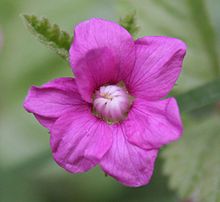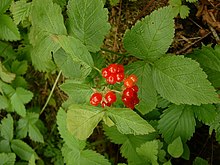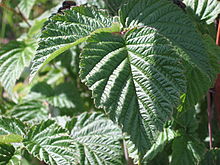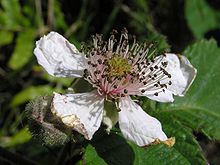Rubus is a large and diverse genus of flowering plants in the rose family, Rosaceae, subfamily Rosoideae, with over 1,350 species.[4][5]
Raspberries, blackberries, and dewberries are common, widely distributed members of the genus, and bristleberries are endemic to North America. Most of these plants have woody stems with prickles like roses; spines, bristles, and gland-tipped hairs are also common in the genus. The Rubus fruit, sometimes called a bramble fruit, is an aggregate of drupelets. The term "cane fruit" or "cane berry" applies to any Rubus species or hybrid which is commonly grown with supports such as wires or canes, including raspberries, blackberries, and hybrids such as loganberry, boysenberry, marionberry and tayberry.[6] The stems of such plants are also referred to as canes.
Description
Most species in the genus are hermaphrodites, Rubus chamaemorus being an exception.
Rubus species have a basic chromosome number of seven. Polyploidy from the diploid (14 chromosomes) to the tetradecaploid (98 chromosomes) is exhibited.
Taxonomy
Modern classification
Rubus is very complex, particularly within the blackberry/dewberry subgenus (Rubus), with polyploidy, hybridization, and facultative apomixis apparently all frequently occurring, making species classification of the great variation in the subgenus one of the grand challenges of systematic botany.
Some treatments have recognized dozens of species each for what other, comparably qualified botanists have considered single, more variable species. On the other hand, species in the other Rubus subgenera (such as the raspberries) are generally distinct, or else involved in more routine one-or-a-few taxonomic debates, such as whether the European and American red raspberries are better treated as one species or two (in this case, the two-species view is followed here, with R. idaeus and R. strigosus both recognized; if these species are combined, then the older name R. idaeus has priority for the broader species).
The classification presented below recognizes 13 subgenera within Rubus, with the largest subgenus (Rubus) in turn divided into 12 sections. Representative examples are presented, but many more species are not mentioned here. A comprehensive 2019 study found subgenera Orobatus and Anoplobatus to be monophyletic, while all other subgenera to be paraphyletic or polyphyletic.[7]
Phylogeny
The genus has a likely North American origin,[7] with fossils known from the Eocene-aged Florissant Formation of Colorado.[8] Rubus expanded into Eurasia, South America, and Oceania during the Miocene.[7] Fossil seeds from the early Miocene of Rubus have been found in the Czech part of the Zittau Basin.[9] Many fossil fruits of †Rubus laticostatus, †Rubus microspermus and †Rubus semirotundatus have been extracted from bore hole samples of the Middle Miocene fresh water deposits in Nowy Sacz Basin, West Carpathians, Poland.[10]
Molecular data have backed up classifications based on geography and chromosome number, but following morphological data, such as the structure of the leaves and stems, do not appear to produce a phylogenetic classification.[11]
Species
Better-known species of Rubus include:
A more complete subdivision is as follows:
-
Subgenus Anoplobatus
-
Subgenus Chamaebatus
-
Subgenus Chamaemorus
-
Subgenus Comaropsis
-
Subgenus Cylactis
-
Subgenus Diemenicus
-
Subgenus Dalibardastrum
-
Subgenus Idaeobatus
-
Subgenus Lampobatus
-
Subgenus Malachobatus
-
Subgenus Micranthobatus
-
Subgenus Orobatus
-
Subgenus Rubus (formerly known as subgenus Eubatus)
-
Sections
- Sect. Allegheniensis
- Sect. Arguti
- Sect. Caesii
- Sect. Canadenses
- Sect. Corylifolii
- Sect. Cuneifolii
- Sect. Hispidi
- Sect. Procumbentes (formerly known as Sect. Flagellares)
- Sect. Rubus
- Rubus acheruntinus
- Rubus adornatus
- Rubus adspersus
- Rubus ahenifolius
- Rubus alterniflorus
- Rubus ammobius
- Rubus amplificatus
- Rubus anglocandicans
- Rubus angustifrons
-
Rubus armeniacus (syn. R. discolor)
- Rubus arrhenii
- Rubus atrichantherus
- Rubus axillaris
- Rubus bakerianus
- Rubus bavaricus
- Rubus bayeri
- Rubus bertramii
-
Rubus bifrons – Himalayan blackberry
- Rubus bloxamianus
- Rubus bloxamii
- Rubus bollei
- Rubus boreanus
- Rubus braeuckeri
- Rubus bregutiensis
- Rubus calvatus
-
Rubus canescens – woolly blackberry
- Rubus cardiophyllus
- Rubus caucasicus
- Rubus chlorothyrsos
- Rubus chrysoxylon
- Rubus cimbricus
- Rubus cissburiensis
- Rubus clusii
- Rubus colemannii
- Rubus concolor
- Rubus conothyrsoides
- Rubus cordifolius
- Rubus cyri
- Rubus dasyphyllus
- Rubus divaricatus
- Rubus diversus
- Rubus drejeri
- Rubus dumnoniensis
- Rubus echinatoides
- Rubus echinatus
- Rubus egregius
- Rubus eianus
- Rubus ergii
- Rubus errabundus
- Rubus erythrops
- Rubus fissus
- Rubus foliosus
- Rubus formidabilis
- Rubus furvicolor
- Rubus fuscoater
- Rubus fuscus
- Rubus gelertii
- Rubus georgicus
- Rubus glandithyrsos
- Rubus glanduliger
- Rubus glandulosus
- Rubus gordonii
- Rubus grabowskii
- Rubus gratus
- Rubus gremlii
- RUbus hartmanii
- Rubus hirtus
- Rubus hylophilus
- Rubus ieri
- Rubus inermis
- Rubus infestus
- Rubus insularis
- Rubus laciniatus
- Rubus lamprophyllus
- Rubus lespinassei
- Rubus leucostachys
- Rubus linkianus
- Rubus macrophyllus
- Rubus micans
- Rubus miszczenkoi
- Rubus montanus
- Rubus moschus
- Rubus mucronulatus
- Rubus mulleri
- Rubus nessensis
- Rubus nitidoides
- Rubus pedatifolius
- Rubus pedemontanus
- Rubus piceetorum
- Rubus plicatus
- Rubus polyanthemus
- Rubus praecox
- Rubus promachonicus
- Rubus pyramidalis
- Rubus radula
- Rubus rhamnifolius
- Rubus rosaceus
- Rubus rubritinctus
- Rubus rudis
- Rubus sanctus
- Rubus scheutzii
- Rubus schlechtendalii
- Rubus schleicheri
- Rubus senticosus
- Rubus separinus
- Rubus septentrionalis
- Rubus slesvicensis
- Rubus sprengelii
- Rubus sulcatus
- Rubus thrysiflorus
- Rubus ulmifolius
-
Rubus vestitus – European blackberry
- Rubus vigorosus
- Rubus vulgaris
- Sect. Setosi (bristleberries)
- Sect. Ursini (Pacific berries)
- Sect. Verotriviales (Southern dewberries)
Hybrid berries
The term "hybrid berry" is often used collectively for those fruits in the genus Rubus which have been developed mainly in the U.S. and U.K. in the last 130 years. As Rubus species readily interbreed and are apomicts (able to set seed without fertilisation), the parentage of these plants is often highly complex, but is generally agreed to include cultivars of blackberries (R. ursinus, R. fruticosus) and raspberries (R. idaeus). The British National Collection of Rubus stands at over 200 species and, although not within the scope of the National Collection, also hold many cultivars.[12][13]
The hybrid berries include:-[14]
-
loganberry (California, U.S., 1883) R. × loganobaccus, a spontaneous hybrid between R. ursinus 'Aughinbaugh' and R. idaeus 'Red Antwerp'
-
boysenberry (U.S., 1920s) a hybrid between R. idaeus and R. × loganobaccus
-
olallieberry (U.S., 1930s) a hybrid between the loganberry and youngberry, themselves both hybrid berries
-
veitchberry (Europe, 1930s) a hybrid between R. fruticosus and R. idaeus
-
skellyberry (Texas, U.S., 2000s), a hybrid between R. invisus and R. phoenicolasius
-
marionberry (1956) now thought to be a blackberry cultivar R. 'Marion'
-
silvanberry, R. 'Silvan', a hybrid between R. 'Marion' and the boysenberry
-
tayberry (Dundee, Scotland, 1979), another blackberry/raspberry hybrid
-
tummelberry, R. 'Tummel', from the same Scottish breeding programme as the tayberry
-
hildaberry (1980s), a tayberry/boysenberry hybrid discovered by an amateur grower
-
youngberry, a complex hybrid of raspberries, blackberries, and dewberries
Etymology
The generic name means blackberry in Latin and was derived from the word ruber, meaning "red".[15]
The blackberries, as well as various other Rubus species with mounding or rambling growth habits, are often called brambles. However, this name is not used for those like the raspberry that grow as upright canes, or for trailing or prostrate species, such as most dewberries, or various low-growing boreal, arctic, or alpine species. The scientific study of brambles is known as "batology".
See also
References
-
^ a b "Rubus". Germplasm Resources Information Network (GRIN). Agricultural Research Service (ARS), United States Department of Agriculture (USDA). Retrieved 2010-06-27.
-
^ "Rubus L.". Tropicos. Missouri Botanical Garden. Retrieved 2010-06-27.
-
^ Alice, Lawrence A.; Goldman, Douglas H.; Macklin, James A.; Moore, Gerry (2014). "Rubus". In Flora of North America Editorial Committee (ed.). Flora of North America North of Mexico (FNA). Vol. 9. New York and Oxford – via eFloras.org, Missouri Botanical Garden, St. Louis, MO & Harvard University Herbaria, Cambridge, MA.
-
^ "Rubus L." Plants of the World Online. Board of Trustees of the Royal Botanic Gardens, Kew. 2021. Retrieved 4 September 2021.
-
^ Brouillet, Luc (2014). "Rosaceae (subfam. Rosoideae) tribe Rubeae". In Flora of North America Editorial Committee (ed.). Flora of North America North of Mexico (FNA). Vol. 9. New York and Oxford – via eFloras.org, Missouri Botanical Garden, St. Louis, MO & Harvard University Herbaria, Cambridge, MA.
-
^ Klein, Carol (2009). Grow your own fruit. United Kingdom: Mitchell Beazley. p. 224. ISBN 978-1-84533-434-5.
-
^ a b c Carter, Katherine A.; Liston, Aaron; Bassil, Nahla V.; Alice, Lawrence A.; Bushakra, Jill M.; Sutherland, Brittany L.; Mockler, Todd C.; Bryant, Douglas W.; Hummer, Kim E. (2019-12-20). "Target Capture Sequencing Unravels Rubus Evolution". Frontiers in Plant Science. 10: 1615. doi:10.3389/fpls.2019.01615. ISSN 1664-462X. PMC 6933950. PMID 31921259.
-
^ Leopold, Estella B.; Manchester, Steven R.; Meyer, Herbert W. (2008), "Phytogeography of the late Eocene Florissant flora reconsidered", Paleontology of the Upper Eocene Florissant Formation, Colorado, Geological Society of America, doi:10.1130/2008.2435(04), ISBN 978-0-8137-2435-5, retrieved 2021-09-23
-
^ Acta Palaeobotanica – 43(1): 9-49, January 2003 – Early Miocene carpological material from the Czech part of the Zittau Basin – Vasilis Teodoridis
-
^ Łańcucka-Środoniowa M.: Macroscopic plant remains from the freshwater Miocene of the Nowy Sącz Basin (West Carpathians, Poland) [Szczątki makroskopowe roślin z miocenu słodkowodnego Kotliny Sądeckiej (Karpaty Zachodnie, Polska)]. Acta Palaeobotanica 1979 20 (1): 3-117.
-
^ Lawrence A. Alice & Christopher S. Campbell (1999). "Phylogeny of Rubus (rosaceae) based on nuclear ribosomal DNA internal transcribed spacer region sequences". American Journal of Botany. Botanical Society of America. 86 (1): 81–97. doi:10.2307/2656957. JSTOR 2656957. PMID 21680348.
-
^ National Collection of Rubus Species, Houghton, England, United Kingdom
-
^ "Plant Heritage – National Collections Scheme, UK Garden Plants". nccpg.com. Retrieved 20 January 2015.
-
^ Ardle, John (July 2013). "Hybris vigour". The Garden.
-
^ Quattrocchi, Umberto (2000). CRC World Dictionary of Plant Names. Vol. IV R-Z. Taylor & Francis US. p. 2345. ISBN 978-0-8493-2678-3.

















